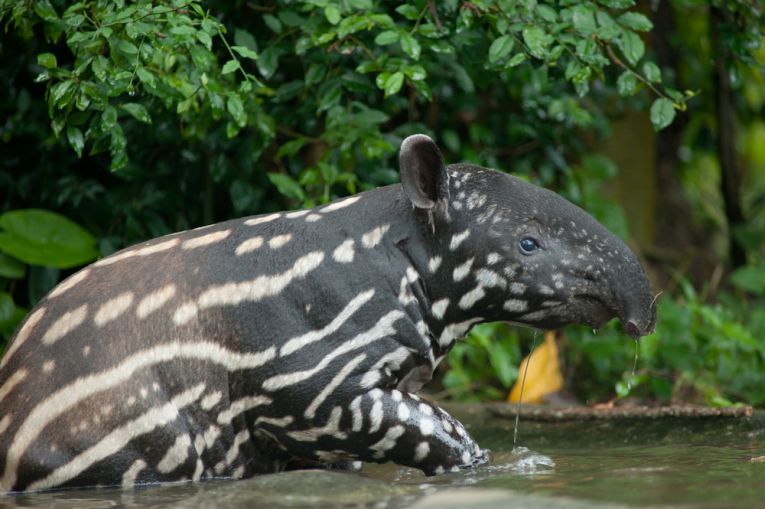In a group known as the perissodactyls, the hooved tapirs show their relations are horses and rhinos. The toes give it away, but that fleshy prehensile "nose" is an ancient mammal's unique way of feeding, detecting and even breathing with a snorkel! The palaeontologists even think the early horse-like fossil, Hyracotherium is an ancestor.
The four recognised species today are separated by a great stretch of the northern hemisphere which seems to have lost all the species in between. Yep, there was even a Tapirus californicus! Conservation is the order of the day for all four of the speies left. The biggest, with the longest nose, is the Malayan tapir, Tapirus indicus.
This species is the black and white one that stands out, just like the young of all four species. They have the attractive spotted, almost rainwater drop speckled pattern that is shown above. Baird's tapir is also large, bigger than the other two, American species. The mountain and the lowland tapirs.
Less attractive is the way native tribes are still allowed to hunt the last few free animals. The conservation of the Baird's tapir, Tapirus bairdii in Nicaragua requires a reserve where it is safe, not to be killed. Around the world the habitats have all but gone, so we need them and the big fauna to survive in any way possible.
That means persuading people that these animals are treasured and they must not eat them. Human culture is much more adaptable than an animal's extinction. With one youngster each, and 400 days to carry them, the females have a fraught time with the job of reproduction. Dr. Eduardo Sacasa has been pictured at the Managuan National Zoo with his captive charges.
However, Maya and Carburito are about to be released at the reserve of Kahka Creek on the Caribbean coast, where Dr. Sacasa claims, "many small farmers are willing to cooperate to save Nicaragua's tapirs." With only 500 left (a few thousand totalled in Central America), it is to be hoped he is correct. 65 cameras will help to keep track, while the two are also fitted with electronic trackers. Enrique Rimbaud of Amarte, the animal protection group, would possibly be more worried about the fate of Central American tapirs, if the fence that is being erected at the moment isn't funded quickly.
The evolution of these creatures is fascinating. How bad is it that we are in at the end of their long careers as a sideshow in the Hoofs Arena: See How mammals got so big.










